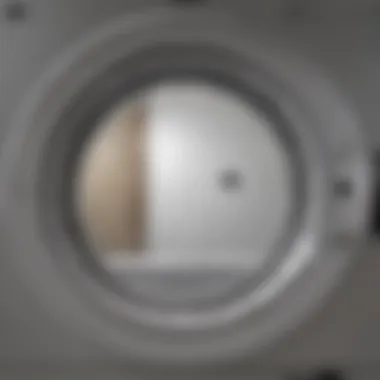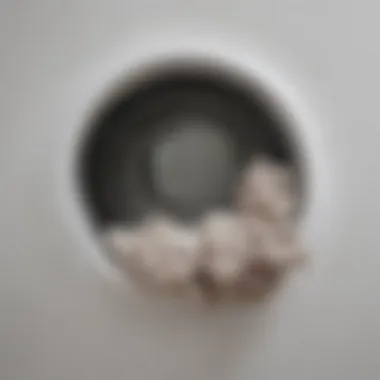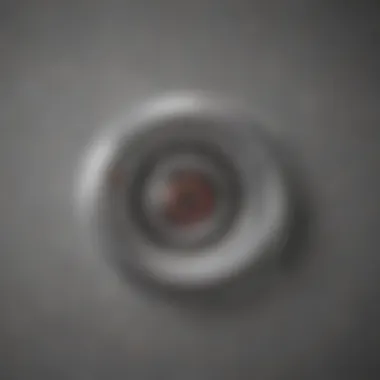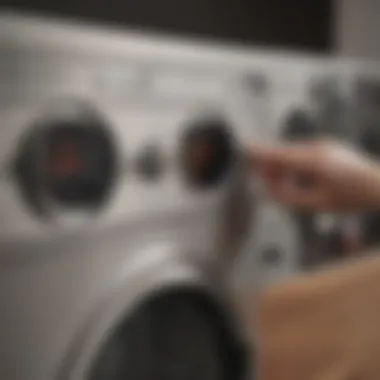Troubleshooting a Dryer That Doesn't Dry Clothes


Intro
When a dryer stops working effectively, it can be a frustrating experience. Clothes may come out damp or, worse, not dried at all. Several factors can contribute to this problem, and understanding them can make troubleshooting easier. This guide aims to lay out these common issues and provide actionable solutions to get your dryer back to optimal performance.
While many homeowners may feel overwhelmed by appliance problems, the good news is that a basic understanding of how dryers function can empower users to tackle challenges confidently. This article covers everything from minor maintenance tips to in-depth technical causes of your dryer woes.
Understanding the Basics of Dryer Functionality
A dryer operates by circulating warm air through clothing to evaporate moisture. The key elements involved in this process include:
- Heating element: Responsible for warming the air.
- Drum: Where the clothes tumble.
- Ventilation system: Allows moisture-laden air to escape.
- Moisture sensors: Help gauge the level of remaining moisture in the clothes.
Recognizing the role of each component will enhance your ability to troubleshoot effectively when drying issues arise.
"Regular maintenance can significantly extend the lifespan of your dryer, improving its efficiency over time."
Common Problems and Solutions
Understanding specific indicators can help pinpoint the issue at hand. Below are some frequent problems and suggested solutions:
Inadequate Heat
One primary reason why clothes remain damp is insufficient heat.
- Check the Heating Element: Ensure it is functioning properly. If it fails, the dryer will not produce the necessary heat.
- Inspect the Thermostat: A malfunctioning thermostat may misread temperature levels, resulting in inadequate heating.
Blocked Ventilation
A blocked vent can trap moist air, preventing effective drying.
- Clean the Lint Trap: Always clean this filter after each use.
- Inspect the Vent Duct: Ensure it is clear and not kinked or blocked by any debris.
Overloading the Dryer
Loading too many clothes can hinder the drying process.
- Reduce Load Size: Smaller loads circulate air better and dry more evenly.
Faulty Moisture Sensors
If these sensors malfunction, the dryer may stop too early.
- Clean the Sensors: Dust and fabric softener residues can build up, affecting their functionality.
Door Seals and Lint Accumulation
Poor seals can lead to heat and moisture escaping.
- Inspect Door Seals: Ensure they are intact and not damaged.
- Check for Lint Buildup: Accumulated lint can trap moisture; regular cleaning is vital.
Preventative Measures
Taking steps to prevent issues can help ensure optimal dryer performance.
- Regular Maintenance: Schedule routine checks to ensure that all components are working correctly.
- Consider a Professional Inspection: Especially if you notice recurring problems.
Epilogue
Understanding your dryer and how it works empowers you to troubleshoot drying issues competently. By maintaining awareness of common problems and engaging in preventative measures, you can enhance the lifespan and functionality of your appliance. Don’t let a faulty dryer disrupt your routine; know the signs and take action to solve them correctly.
Prologue to Dryer Problems
Addressing dryer issues is essential for maintaining an efficient laundry routine. A malfunctioning dryer not only hampers the convenience of drying clothes but also impacts household productivity. Understanding the common problems that arise with dryers helps users tackle these issues proactively. Moreover, efficient drying is critical for preserving fabric quality and preventing damage over time.


The Importance of Efficient Drying
Efficient drying is vital for multiple reasons. First, it conserves energy, which reduces utility costs. An efficient dryer uses less energy to dry the same load compared to one that is malfunctioning. Second, it extends the lifespan of fabrics, as they are less likely to suffer from wear and tear when dried correctly. Finally, efficient dryers enhance overall satisfaction with laundry tasks, reducing the frustration associated with repeated drying cycles.
Common Indicators of Dryer Malfunction
Recognizing the signs of dryer malfunction can save time and money. Common indicators include:
- Long Drying Times: If clothes are still damp after a regular cycle, this points to potential issues.
- Unusual Noises: Grinding, squeaking, or thumping sounds are often signs of internal problems.
- Overheating: A dryer that feels excessively hot may be struggling to ventilate properly.
- Burning Smell: This is a serious issue. It demands immediate attention as it could indicate a fire hazard.
Once these indicators are noted, homeowners can better assess the specific problems affecting their dryers, enabling them to take appropriate steps toward resolution. Addressing these issues quickly is crucial to avoid further damage and ensure clothes are dried efficiently.
Understanding the Mechanics of Dryers
Understanding how dryers work is critical to diagnosing issues effectively. This knowledge sheds light on the processes involved, enabling individuals to pinpoint problems with greater precision. Knowing the basic mechanics also helps in recognizing the limitations of dryers and the significance of their maintenance for long-lasting operation.
How Dryers Work
Dryers employ a combination of heat, airflow, and tumbling to remove moisture from clothes. Here’s a simplified explanation:
- Heat Generation: The dryer heats air through electric coils or gas burners. This heated air is essential for the drying process.
- Airflow: The dryer uses a fan to circulate the warm air over the wet clothes. This action helps evaporate the moisture from fabrics.
- Tumbling Action: The rotation of the dryer drum allows the clothes to move, ensuring even exposure to the warm air. Without this tumbling, clothes may not dry properly as they can clump or stick together.
- Moisture Removal: As the air circulates, it picks up moisture from the clothes and is expelled outside through venting.
Through these mechanisms, dryers convert wet fabrics into dry ones, however, any disruption in these processes can lead to drying issues.
Types of Dryers
Understanding the types of dryers is crucial for identifying potential issues related to specific dryer models. The main categories of dryers include:
- Vented Dryers: These dryers expel moisture-laden air outside through a vent. They are generally the most common type.
- Condenser Dryers: Unlike vented dryers, these do not require external venting. They collect moisture in a tank, which needs to be emptied after cycles.
- Heat Pump Dryers: These are energy-efficient units that use a heat pump to dry clothes without significant electricity consumption. They are often more expensive but can save money in the long run.
- Washer-Dryer Combos: These appliances combine washing and drying functions into one unit. They are suitable for small spaces but can have longer drying times.
Knowing the type of dryer is important. Different models have distinct mechanisms which affect troubleshooting strategies.
By understanding these basics of dryer operation, users can approach troubleshooting with a more informed mindset. Recognizing how to address common issues may save time and money in maintenance.
Initial Troubleshooting Steps
The initial troubleshooting steps are crucial for anyone facing a dryer that fails to dry clothes properly. Many users may not realize that often, a simple check could identify the issue and even provide a quick fix. These steps serve as the groundwork for more detailed investigation, allowing individuals to rule out basic problems before delving into complex mechanical issues. Moreover, addressing these preliminary concerns can save time and reduce potential repair costs.
Check Power Supply
First and foremost, assessing the power supply is essential. A dryer needs sufficient electrical power to operate effectively. Ensure that the dryer is plugged in securely and check the outlet for functionality. You can test the outlet with another appliance or a voltage tester. If the outlet seems dysfunctional, it may need to be reset, or an electrician may need to be called to resolve wiring issues. Additionally, remember that many dryers require a 240-volt outlet. Ensure this requirement is met, as inadequate voltage can lead to inefficient drying. Check the circuit breaker as well; a tripped breaker often causes power loss to the appliance.
Inspect the Dryer Settings
Another essential step is inspecting the dryer settings. Many users might unintentionally select incorrect drying options or forget to adjust the machine for heavy fabrics. Verify that the dryer is set to the appropriate drying cycle for the clothing load. For example, heavier fabrics like towels might need extended drying times. Furthermore, ensure that settings such as heat level are appropriate for the items being dried. Many modern dryers include specific cycles for various fabric types. Familiarize yourself with these options to optimize drying performance. If your dryer has a sensor system, check if it is working correctly; settings may affect its operation.
Remember: Regular checks of both power supply and settings can often resolve basic issues, keeping your dryer in optimal working condition.
Common Causes of Ineffective Drying
Understanding the common causes of ineffective drying is essential for anyone experiencing challenges with their dryer. Identifying these issues allows users to take timely action, potentially saving both time and money. A dryer that does not perform efficiently can become a source of frustration, impacting daily routines and laundry schedules. By recognizing the reasons behind these problems, one can address them directly and restore the dryer’s functionality quickly.
Overloading the Dryer
Overloading the dryer is a frequent mistake many make. When the drum is full, clothes struggle to tumble freely. This lack of movement hinders the effectiveness of drying. To prevent this, it’s advisable to load the dryer to no more than three-quarters of its capacity. Additionally, bulky items like comforters or towels should ideally be dried separately to enhance airflow.
Lint Filter Issues
Lint filters are designed to trap excess lint and debris during the drying cycle. If the lint filter is clogged, the dryer cannot circulate air properly. This results in inadequate drying. It is necessary to clean the lint filter before each load as part of the routine maintenance. Furthermore, the filter may need thorough cleaning with soap and water every few months to remove buildup that could impede airflow. Ignoring this can also pose a fire hazard.
Ventilation Problems
Ventilation is another crucial aspect of dryer performance. If the vent hose is damaged or blocked, moist air will not escape efficiently. This causes the dryer to work harder, leading to longer drying times or even complete failure. It's important to inspect the venting regularly. Ensure there are no kinks in the hose, and that outside vents are clear from obstruction. If air flow is limited, installation of a new vent may be needed.
Moisture Sensor Malfunction


The moisture sensor is instrumental in determining when clothes are dry. If this sensor malfunctions, it might fail to detect adequate dryness, causing extended drying times or incomplete drying. Users should regularly check the sensor for debris or buildup that could impair its functionality. To test the sensor, one can run a cycle with a known wet load and observe whether the dryer shuts off appropriately. Should issues persist, replacement of the sensor may be necessary.
Addressing these common causes can significantly improve the drying performance of the appliance, leading to efficiency and savings.
Detailed Investigation of Lint Filter and Vent Issues
The lint filter and venting system are essential components of a dryer. A detailed investigation of these areas is crucial for diagnosing why a dryer does not dry clothes effectively. Lint buildup may seem minor, but it can severely impact drying performance and safety. Poor ventilation can lead to increased drying times and even fire hazards.
Maintaining these systems ensures that the dryer operates smoothly, prevents mechanical failure, and extends its lifespan. By addressing these issues, users can significantly improve the drying efficiency of their appliances, allowing for optimal performance during each cycle.
Cleaning the Lint Trap
Cleaning the lint trap is one of the simplest yet most important steps in dryer maintenance. Every time clothes are dried, lint accumulates in the trap. If left unchecked, the buildup can obstruct airflow. This obstruction limits drying efficiency and forces the dryer to work harder.
A blocked lint trap can lead to the following problems:
- Increased drying time
- Higher energy consumption
- Potential overheating of the dryer
To clean the lint trap:
- Open the lint filter compartment.
- Remove the lint from the screen. Use a soft brush or a handheld vacuum if necessary.
- Wash the screen with water to remove any residue or fabric softener buildup, then thoroughly dry it.
- Ensure to replace it firmly in its place before operating the dryer again.
Regular cleaning of the lint trap should become a part of the laundry routine. This simple action can greatly improve the dryer’s performance.
Examining the Vent Hose
The vent hose plays a vital role in directing moist air from the dryer to the outside. If the hose is kinked, obstructed, or damaged, it can reduce airflow and result in prolonged drying cycles. Additionally, a poorly functioning vent hose can trap moisture and lint, leading to the risk of overheating.
To examine the vent hose, follow these steps:
- Disconnect the dryer from the power source.
- Locate the vent hose connecting the dryer to the wall.
- Inspect for any visible kinks or blockages.
- Detach the hose and clean it thoroughly. You may use a vacuum attachment to catch dust and lint that may be lodged inside.
- Check for signs of damage that might require replacement.
A clean and well-positioned vent hose is crucial for optimal dryer function. Addressing these minor issues can prevent major problems in the future.
Inspecting Outside Vent for Blockages
The outside vent is the final path for hot, moist air to exit the home. Any blockage here can signify major problems. Leaves, debris, or even nests can obstruct airflow. If the vent is blocked, air cannot escape, causing the dryer to fail in drying clothes effectively.
To inspect the outside vent:
- Locate the external vent on the outside wall.
- Check for any visible obstructions.
- Clear leaves, sticks, or any buildup that may be present.
- Ensure the vent flap opens easily. If it is stuck, it might need cleaning or repair.
This step is essential to maintaining proper airflow, which is fundamental for the dryer to operate efficiently. Neglecting it can lead to significant issues that may require professional assistance.
Keeping the lint filter and vent systems clear is not just about performance; it is also about safety. Regular maintenance can significantly reduce the risk of dryer-related fires.
Addressing Moisture Sensor Issues
Moisture sensors play a crucial role in the effective operation of dryers. They measure the level of humidity within the dryer drum and help determine when clothes are sufficiently dry. This ensures that the drying cycle operates efficiently, conserving energy and preventing unnecessary wear on fabrics. Failing sensors can lead to prolonged drying times or, in some cases, the dryer not completing a cycle at all. Hence, the significance of addressing moisture sensor issues cannot be overstated in achieving optimum dryer performance.
Identifying Sensor Problems
Identifying problems with the moisture sensor involves observation and troubleshooting. Common indicators of sensor failure include clothes that remain damp at the end of the cycle or the dryer running for an excessively long time without achieving dryness.
- Visual Inspection: Check the moisture sensor, usually located in the dryer drum. Look for any signs of damage, including corrosion or physical obstruction from lint.
- Feel for Abnormalities: When inspecting the sensor, it should not have a buildup of lint. If it does, this can impede its ability to measure moisture correctly.
- Clothes Behavior: If you consistently notice that loads come out wetter than expected, or if the dryer frequently switches to cool down mode, these could signify issues.
Testing Moisture Sensors
Testing moisture sensors requires a pragmatic approach that combines functionality checks with technical assessments.
- Multimeter Test: Use a multimeter to check the continuity of the sensors. Set the multimeter to the resistance mode and connect the probes to the terminals of the sensor. A reading of zero or near zero ohms indicates that the sensor is likely functioning well.
- Calibration Check: Some dryer models allow for calibration of moisture sensors. Consult the user manual for specific instructions on how to perform this test to ensure accuracy in moisture detection.
- Drying Cycle Tests: Run multiple drying cycles with different fabric types to see how the sensor responds. If it fails to adjust its timing based on fabric weight and moisture levels, service or replacement may be necessary.
- Capacity Check: As a basic check, try loading the dryer with a standard-sized load. If the sensors still behave erratically under consistent conditions, they are probably malfunctioning.
Addressing moisture sensor issues can lead to significant improvements in dryer efficiency and fabric care, making maintenance a necessity for any dryer owner.


By focusing on the moisture sensor, users can minimize the hassle of ineffective drying and enjoy the benefits of a properly functioning appliance.
When to Call a Professional
When a dryer fails to dry clothes, it can lead to frustration and wasted time. Many issues can be resolved through simple troubleshooting, but sometimes the problems are more complex. Understanding when to step back and call in a professional is essential for several reasons.
One major aspect is safety. If you notice any unusual noises or burning smells, these could be signals of wiring problems or internal component failure. Noticing these indicators should prompt an immediate decision to seek professional help. These issues can pose serious risks, including fire hazards or electrical shock.
Additionally, some problems may require specialized knowledge or tools. For example, if a dryer’s heating element or motor is malfunctioning, these components may need to be replaced. A qualified technician can quickly diagnose these intricate issues and recommend appropriate actions. Such assessments often involve intricate tests and potentially costly repairs, so relying on an expert can save time and avoid further damage.
Finally, there are practical considerations related to cost. Determining whether to fix a dryer should include evaluating the estimated expense against the cost of a new model. A technician can provide a thorough cost-benefit analysis that aligns with your financial situation.
In summary, identifying when to call a professional can help you avoid further complications, ensure safety, and save money in the long run. When faced with persistent problems after basic troubleshooting, do not hesitate to seek expert assistance.
Signs of Major Issues
There are specific indicators that suggest serious problems with a dryer, necessitating professional intervention.
- Unusual Noises: Any loud or strange sounds while operating may indicate mechanical failure.
- Reduced Efficiency: If the dryer consistently takes longer than usual to dry clothes, it may point to a deeper issue.
- Burning Smell: This can signify overheating components or electrical issues, which are alarming symptoms.
- Repeated Error Codes: Some modern dryers have digital displays that show error codes. Frequent codes suggest technical faults requiring expert help.
Recognizing these signs allows for timely intervention, protecting both the appliance and your home.
Cost Considerations
When deciding to repair a dryer, the financial implications are critical. Repair costs can fluctuate widely based on the specific problem. Some services may charge a flat fee, while others operate hourly.
In general, you can anticipate the following:
- Minor Repairs: These usually range from $100 to $200, including simple fixes like belt changes or minor electrical repairs.
- Major Component Replacement: It can cost $250 or more, particularly if replacing heating elements or motors.
- Extended Repairs: If multiple problems exist, repair costs may rise significantly, sometimes being close to the price of a new dryer.
When weighing repair against replacement, it is sensible to look into the age and reliability of the current dryer. If it is older than 10 years, investing in a new model might be more economical in the long term.
Preventative Maintenance Practices
Preventative maintenance is a crucial component for ensuring the longevity and efficiency of your dryer. Regular attention to the functionality of your appliance can significantly reduce the likelihood of unexpected breakdowns and the associated costs of repairs. By establishing a routine maintenance schedule, you can keep the dryer operating at its best and possibly enhance its performance.
Regular Cleaning Routines
Implementing regular cleaning routines is vital for maintaining the health of your dryer. One of the primary areas that require attention is the lint filter. Cleaning the lint filter after every use is not just a recommendation; it is an essential practice. A clogged lint filter can restrict airflow, which may lead to longer drying times and increased energy consumption.
Additionally, the dryer drum and the exterior of the appliance should be wiped clean regularly. This minimizes buildup of dust and debris, which can affect functionality. You should also consider vacuuming the venting system every few months to eliminate accumulated lint in the ducts. Neglecting these simple yet effective cleaning methods can put unnecessary strain on your dryer, escalating the risk of malfunction.
Scheduled Inspections
Beyond routine cleaning, scheduled inspections play a pivotal role in preventative maintenance. Setting a specific time each year to examine critical components of your dryer can identify potential problems before they escalate.
During an inspection, check the ventilation system for any obstructions. Blocked vents can lead to overheating and may elevate fire risk. Assess the condition of the wiring and plug as well; frayed wires or loose connections can result in dangerous situations. Furthermore, examining the moisture sensor and drum for any signs of wear can help detect issues that may impair drying efficiency.
Regular inspections can prevent small issues from becoming major repairs.
The priority of preventative maintenance should be clear. This approach not only optimizes dryer function but also promotes safety and energy efficiency. By taking proactive steps, you pave the way for uninterrupted and effective drying.
Culmination
In closing, understanding the ins and outs of dryer troubleshooting is essential for anyone aiming to maintain or improve their appliance's performance. This article has discussed various aspects from basic troubleshooting to deeper investigations into malfunctions. The importance of this knowledge cannot be understated. It not only saves time but also prevents unnecessary costs associated with repairs or replacements. Knowing how to address common problems and recognizing signs that a dryer requires professional attention is crucial in preserving functionality.
Summary of Key Points
Overall, the key points to remember include the following:
- Inspecting initial symptoms: Recognize signs of dryer inefficiency, such as damp clothes after a cycle.
- Understanding common malfunctions: Overloading, lint buildup, and ventilation issues can significantly affect drying performance.
- Routine maintenance: Regular cleaning and timely inspections can prevent many common problems
"Proactive maintenance is more cost-effective than reactive repairs."
Final Recommendations
To ensure sustained performance of your dryer, follow these final recommendations:
- Implement regular cleaning routines: Make it a habit to clean the lint filter after every use and carry out a deep clean periodically.
- Schedule professional inspections: Engage specialists for thorough checks every year to keep your appliance in optimal condition.
- Avoid overloading the dryer: Be mindful of the capacity to prevent strain and achieve effective drying.
In practicing these methods, a dryer can serve its purpose efficiently, providing dry clothes consistently while extending the appliance’s lifespan.







